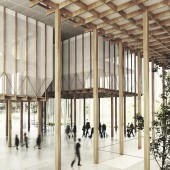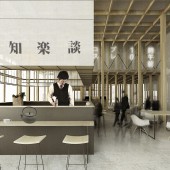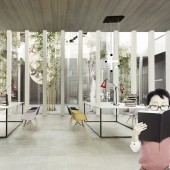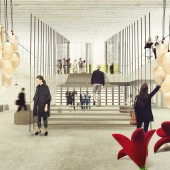Tokyo Pop Lab, Monsters in a Jar Multifunctional Cultural Center by StudioBisù |
Home > Winners > #61728 |
 |
|
||||
| DESIGN DETAILS | |||||
| DESIGN NAME: Tokyo Pop Lab, Monsters in a Jar PRIMARY FUNCTION: Multifunctional Cultural Center INSPIRATION: Tokyo pop lab is a multifunctional building that aims to combine the traditional oriental architecture with the contemporary japanese culture. The project uniquely inverts the traditional model of a contained exhibition space by distributing media throughout the primary public space - the circulation surrounding the differentiated volumes. Within each of the distributed volumes, academic functions including classrooms and a lecture hall, are contained. UNIQUE PROPERTIES / PROJECT DESCRIPTION: "Monstern in a jar" is a civic pavilion, interrupted variously by hoisted volumes destined to discrete and localized, academic and cultural activities. Below and in-between these floating volumes, urban life extends seamlessly into the building. Through an open, and carefully considered plan, the scheme establishes an urban, public forum to exhibit, celebrate, discuss, and debate, the popular culture in its various forms. OPERATION / FLOW / INTERACTION: Tokyo Pop Lab can be described as a civic pavilion, interrupted variously by hoisted volumes of discrete, localized activity. Below and in-between these floating volumes, urban life extends seamlessly into the building, perhaps resembling most closely the precedent of a colonnade or piazza. Through an open, and carefully considered plan, the scheme establishes an urban, public forum for popular culture. The project uniquely inverts the traditional model of a contained exhibition space by distributing media throughout the primary public space — the circulation surrounding the differentiated volumes. Within each of the distributed volumes, academic functions including classrooms and a lecture hall, are contained. Rather than assume a singular or limited expression, the proposal establishes a forum to exhibit, celebrate, discuss, and debate, the ebb and flow of popular culture in its various forms of expression through thoughtful programming of public space. Tokyo pop lab is a multifunctional building that aims to combine the traditional oriental architecture with the contemporary japanese culture. The project uniquely inverts the traditional model of a contained exhibition space by distributing media throughout the primary public space - the circulation surrounding the differentiated volumes. Within each of the distributed volumes, academic functions including classrooms and a lecture hall, are contained. PROJECT DURATION AND LOCATION: Tokyo, Japan. Competition 2015/2016 FITS BEST INTO CATEGORY: Architecture, Building and Structure Design |
PRODUCTION / REALIZATION TECHNOLOGY: The building is a glass case characterized in his interiors spaces from wooden structural elements, that suggesting the feature of japanese traditional architecture. The upper volumes are wrapped in a fabric that contains internal led; a material that creates a neutral and elegant environments during the daytime but that could also been used as screen during the night. SPECIFICATIONS / TECHNICAL PROPERTIES: In the ground floor (1600 m2) ,completely permeable, are located reception area, exhibition 80 m2, workshop space 300 m2, café 135 m2, 3 patio, and a public japanese garden 300 m2. The library (300 m2), the it suite (70 seat) and the reading room are situated underground. All the academic (lecture room 4 x 80 m2), administrative (meeting room 2 x 55 m2, office 200 m2), and cultural ( conference room 2 x 140 m2, auditoriumforum 300 seat, exhibition 240 m2) are located in the floating volumes. TAGS: tokyopoplab, tokyo, chiyoda, japan, competition, culture, exhibition, library, auditorium, center RESEARCH ABSTRACT: The main challenge was to design a public space with a great mix of functions, which could be the symbol of japanese pop culture. A culture so different and distant from the western one, and in a city already rich in landmarks. CHALLENGE: "Monstern in a jar" arises from an in-depth search for the cult of pop japanes from art to kitchen, rich in unique characters and objects, from the study of traditional japanese architecture known for its elegance and the use of natural materials, and not least from the study of contemporary cases of architectures distinct from cultural use. ADDED DATE: 2017-09-30 19:31:14 TEAM MEMBERS (4) : Cinzia Stella, Leonardo Ramondetti, Marco Lagamba and Francesco Montesoro IMAGE CREDITS: Image #1: Creator Marco Lagamba, monsters, 2015. Optional Image #1: Creator Marco Lagamba, exhibition, 2015. Optional Image #2: Creator Marco Lagamba, bar, 2015. Optional Image #3: Creator Marco Lagamba, library, 2015. Optional Image #4: Creator Marco Lagamba, auditorium, 2015. |
||||
| Visit the following page to learn more: https://cinziastella.wordpress.com/ | |||||
| AWARD DETAILS | |
 |
Tokyo Pop Lab, Monsters in a Jar Multifunctional Cultural Center by Studiobisù is Winner in Architecture, Building and Structure Design Category, 2017 - 2018.· Read the interview with designer StudioBisù for design Tokyo Pop Lab, Monsters in a Jar here.· Press Members: Login or Register to request an exclusive interview with StudioBisù. · Click here to register inorder to view the profile and other works by StudioBisù. |
| SOCIAL |
| + Add to Likes / Favorites | Send to My Email | Comment | Testimonials | View Press-Release | Press Kit |
Did you like Studiobisù's Architecture Design?
You will most likely enjoy other award winning architecture design as well.
Click here to view more Award Winning Architecture Design.








